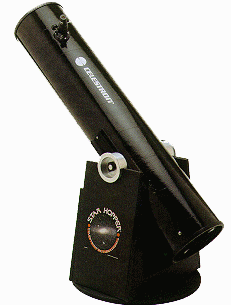Celestron History
![]() Distribution
Distribution ![]() News
News ![]() Notes & Interesting Articles
Notes & Interesting Articles ![]() Products
Products ![]() Pricing
Pricing ![]() Quality Assurance
Quality Assurance

6", 8", 11" , 14" and 17.5" "Star Hopper" Dobsonian Reflector Telescopes
Introduced at Company Seven in December of 1995, Discontinued in 2000Provided for information purposes only.
The Star Hopper Dobsonian telescopes are designed for beginners who seek the best possible view of the faint Deep Sky objects
while on a constrained budget. These include advanced features that an experienced observer will appreciate. Furthermore,
these 6" and 8" aperture units (introduced in November 1995) benefit from years of study of those Dobsonian style telescopes
already on the market; Celestron has improved upon the competing standards. And Company Seven took them another step further
by improving the bearings on those telescopes we sell so that movements are almost feather light! In December 1996 Celestron
improved the designs further and also introduced 11", 14" and a 17.5" aperture models.

History: This is basically a classic Newtonian reflecting telescope on a "Dobson" style of simple mount. The optical design by an English mathematician was first constructed by Sir Isaac Newton. This employs two mirrors (a parabolic and an elliptical flat) to gather and reflect light to focus at a point beyond the focuser; an eyepiece for viewing is placed at the focuser. A good reflector can offer the best view per the dollar especially of the faint, deep sky objects where light gathering power is essential.
The use of a simple Alt-Azimuth mounting, lightweight mirror and modestly priced components evolved from a goal of San Francisco sidewalk astronomer John Dobson to get the most telescope possible into the hands of the amateur observer for the lowest relative cost. Ideally by developing a design which can be home made. This design remains the first choice among serious deep sky observers, and it is not uncommon to find custom or home made 8" to 36" aperture "Dobs" at the astronomical observing events at dark sky observing sites around the U.S.
Noteworthy improvements over conventional economical Dobs include:
- Low Friction Altitude Bearing/Dovetail Pinion Balance Syste
- A unique, low-mass molded Pyrex primary mirror for better thermal stability
- Unique adjustable Pinnacle Mirror Cell to support the low mass Primary Mirror
- Multicoated, high reflectivity mirror coatings improve brightness and contrast.
- Optics hand finished and tested on a 125 line Ronchi
- Cast and Machined 1.25" Diameter Rack & Pinion Focuser
- 1.25" Focuser also accepts .965" diameter oculars with furnished reducer
|
Maximum Height Overall: Maximum Height to The Eyepiece: Weight of Sonotube Optical Tube Assembly: Mass of Carriage: Effective Light Gathering Power: |
57" 48-1/2" 22-1/2 lbs. 31 lbs. 630X That of Human Eye |
Available assembled and laser Collimated by Company Seven's experienced staff, with complimentary course of instruction, or available from Company Seven in kit form, with complimentary course of instruction.
The standard construction employs a Sonotube (impregnated thick wall cardboard tube commonly used in forming concrete for example). However, such a tube construction while it is economical does require more frequent realignment (collimation) of the optics. These telescopes are available assembled and laser Collimated by Company Seven's experienced staff, with complimentary course of instruction. Or are available from Company Seven in kit form, with complimentary course of instruction.
With a versatile f6 ratio (good for high and low magnification observing), the 8" Aperture model is popular among those who desire an easily manageable telescope with the light gathering and fields of view potential for the observing many of the most popular deep sky objects (Galaxies, Star Clusters, Nebulae, Planetary Nebulae, etc.). And still this telescope affords the good contrast and clarity qualities required for lunar and planetary observing which actually reveals changes through out the observing season! With a comparatively small central obstruction, and fewer optical surfaces, the contrast and brightness can actually surpass more expensive designs such as the 8" Schmidt-Cassegrain telescope.
Optional accessories that we highly recommend for your viewing pleasure and long term success:
- "Backyard Astronomers Guide" or "Nightwatch" by Terrence Dickinson, or "Starware" by Phil Harrington. For the novice from age 8 to 15 or so up to adult. Good introductions to astronomy, telescopes, and accessories. Especially easy introduction to finding ones way around the night sky
- Telrad Illuminated Finder: to aid one in finding and centering
objects in the main telescope, and learn the sky by "star hopping" from one object to another
- A high magnification eyepiece for Lunar observing, ideally a 13-15mm Plossl, 9mm Nagler, or a
relatively economical LV series ocular
- A very high magnification eyepiece for Lunar Planetary observing,
ideally 4.8mm Nagler or short focal length (7.4 to 8mm) Ploss, or a relatively economical LV series ocular
- Sky Light Pollution Rejection Filter to reduce the greenish or golden background glow from city lights - this is an aid
to seeing faint Nebulae
- Neutral Density Filter (set of two) to reduce the brightness of the
Moon and Planets, and alleviate discomfort when viewing Moon at one quarter or Full
- Planisphere (Specify Latitude) The easiest way to plan and find what is up in the sky at any given time and date
Go back to Celestron Products page
Contents Copyright 1994-2000 Company Seven - All Rights Reserved

